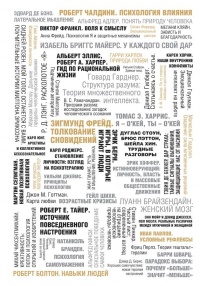Читать книгу "Как хороший человек становится негодяем. Эксперименты о механизмах подчинения. Индивид в сетях общества - Стэнли Милгрэм"
Шрифт:
Интервал:
Закладка:
MANNHEIM, H. (1965). Comparative Criminology. Boston: Houghton Mifflin.
MAO TSE-TUNG (1938). «On protracted war». Reprinted in Selected Military Writings of Mao Tse-Tung. Peking: Foreign Languages Press. 1961, pp. 187–266.
MARTIN, E. D, (1920). The Behavior of Crowds. New York: Harper.
MARX, K. (1848). Manifesto of the Communist Party. Transl. Chicago: Charles H. Kerr, 1888.
MEIER, N. C., G. H. MENNENGA, & H. Z. STOLTZ (1941). «An experimental approach to the study of mob behavior». J. Abnorm. Soc. Psychol., 36, 506–524.
MERTON, R. K. (1960). «The ambivalences of Le Bon’s „The Crowd“». Introduction to G. Le Bon, TheCrowd. New York: Viking Press, pp. v—xxxix.
METHVIN, E. H. (1961). «Mob violence and communist strategy». Orbis, 5, 166–181.
MICHELET, J. (1848). Historical View of the French Revolution (transl. C. Cocks). (Оригинальное издание на французском языке вышло в 1847 г.) London: Bohn.
MILGRAM, S. (1964). «Group pressure and action against a person». J. Abnorm. Soc. Psychol., 69, 137–143.
MILGRAM, S. (1965). «Some conditions of obedience and disobedience to authority». Hum. Relat., 18, 57–76.
MILLARD, C. (1963). Фотографии (январь 1963 г.) в Survey, May 1963.
MINTZ, A. (1951). «Non-adaptive group behavior». J. Abnorm. Soc. Psychol., 46, 150–159.
MOLINEUX, E. L. (1884). Riots and Their Suppression. Boston: Headquarters First Brigade, M. V. M.
NEISSER, U. (1964). «Visual search». Sci. Amer., 210, 94–102.
NORTON, W. J. (1943). «The Detroit riots – and after». Survey Graphic, 32, 317.
OPPENHEIMER, M., & G. LAKEY (1965). A Manual for Direct Action.Chicago: Quadrangle.
ORTEGA Y GASSET, J. (1932). Revolt of the Masses. New York: Norton.
PARK, R. E., & E. W. BURGESS (1921). Introduction to the Science of Sociology. Chicago: Univ. of Chicago Press.
PARKES, A. S., & H. M. BRUCE (1961). «Olfactory stimuli in mammalian reproduction». Science, 134, 1049–1054.
PARSONS, T. (1951). The Social System. Glencoe, Ill.: Free Press.
PENROSE, L. S. (1952). On the Objective Study of Crowd Behavior. London: H. K. Lewis.
PETERSON, W. A., & N. P. GIST (1951). «Rumor and public opinion». Amer. J. Sociol., 57, 159–167.
PINKNEY, D. (1958). Napoleon III and the Rebuilding of Paris. Princeton: Princeton Univ. Press.
RAPOPORT, A. (1963). «Mathematical Models of Social Interaction». В кн.: R. D. Luce, R. R. Bush, and E. Galanter (eds.), Handbook of Mathematical Psychology. New York: Wiley, pp. 493–579.
RASHEVSKY, N. (1939). «Studies in mathematical theory of human relations». Psychometrika, 4, 221–239.
RASHEVSKY, N. (1951). Mathematical Biology of Social Relations. Chicago: Univ. of Chicago Press.
REDL, F. (1942). «Group emotion and leadership». Psychiatry, 5, 573–596.
REICH, W. (1946). The Mass Psychology of Fascism. (German original published 1933.) New York: Orgone Institute Press.
RITTER, P. (1964). Planning for Man and Motor. Frankfurt: Pergamon Press.
ROSS, E. A. (1908). Social Psychology. New York: Macmillan.
RUDÉ, G. (1959). The Crowd in the French Revolution. Oxford: Oxford Univ. Press.
RUDÉ, G. (1964). The Crowd in History. New York: Wiley.
SAPIR, E. (1935). «Fashion». В кн.: Encyclopedia of Social Science. Vol. 6. New York: Macmillan, pp. 139–144.
SCHMECK, H. M. (1966). «Traffic computerized». New York Times, January 16. Section 4, p. 7.
SCHULTZ, D. P. (1964). Panic Behavior: Discussion and Readings. New York: Random House.
SEARS, D. O., & T. M. TOMLINSON (1966). Riot Activity and Evaluation: An Overview of the Negro Survey. Univ. of California, Los Angeles, Department of Psychology. (Mimeo)
SELZNICK, P. (1965). «Reply to Glazer». В кн.: S. M. Lipset & S. S. Wolin (eds.), TheBerkeley Student Revolt. Garden City, N. Y.: Anchor, pp. 303–311.
SHELLOW, R., & D. U. ROEMER (1966). «No heaven for hell’s angels». Transaction, 3, No. 5, 12–19.
SHERIF, M. (1936). The Psychology of Social Norms. New York: Harper.
SHERIF, M., & C. W. SHERIF (1953). Groups in Harmony and Tension: An Integration of Studies on Intergroup Relations. New York: Harper.
SIDIS, B. (1895). «A study of the mob». Atlantic Monthly, 75, 188–197.
SIDIS, B. (1898). The Psychology of Suggestion. New York: Appleton.
SIGHELE, S. (1901). La Foule Criminelle. Paris: Alcan.
SIMMEL, G. (1964). The Sociology of Georg Simmel (transl. K. H. Wolff). London: Free Press.
SMELSER, N. J. (1963). Theory of Collective Behavior. New York: Free Press.
SOBOUL, A. (1964). The Parisian Sans-Culottes and the French Revolution 1793–4. (Оригинальное издание на французском языке вышло в 1958 г.) Oxford: Oxford Univ. Press.
SOPER, H. E. (1929). «Interpretation of periodicity in disease-prevalence». J. Roy. Statist. Soc., 92, 34–47.
TARDE, G. (1898). «Le public et la foule». Revue de Paris, 5, 615–635.
TARDE, G. (1903). The Laws of Imitation (transl. Elsie Parsons). (Оригинальное издание на французском языке вышло в 1901 г.) New York: Holt.
TILLY, C., & J. RULE (1964). «Measuring political upheaval». Неопубликованная рукопись хранится в архиве Joint Center for Urban Studies of MIT and Harvard University.
TOCH, H. (1965). The Social Psychology of Social Movements. New York: Bobbs-Merrill.
TRIVERS, R. (1965). «Riots in American history». Дипломная работа, Harvard College.
TURNER, R. H. (1964). «Collective behavior». В кн.: R. E. L. Faris (ed.), Handbook of Modern Sociology. Chicago: Rand McNally, pp. 382–425.
TURNER, R. H., & L. M. KILLIAN (1957). Collective Behavior. Englewood Cliffs, N. J.: Prentice-Hall.
WADA, G., & J. C. DAVIES (1957). «Riots and rioters». West.Polit. Quart., 10, 864–874.
WALLACH, M. A., N. KOGAN, AND D. J. BEM (1962). «Group influence on individual risk taking». J. Abnorm. Soc. Psychol., 65, 75–86.
WALLAS, G. (1932). The Great Society. New York: Macmillan.
WASKOW, A. I. (1966). From Race-Riot to Sit-In: 1919 and the 1960s. New York: Doubleday.
Внимание!
Сайт сохраняет куки вашего браузера. Вы сможете в любой момент сделать закладку и продолжить прочтение книги «Как хороший человек становится негодяем. Эксперименты о механизмах подчинения. Индивид в сетях общества - Стэнли Милгрэм», после закрытия браузера.




